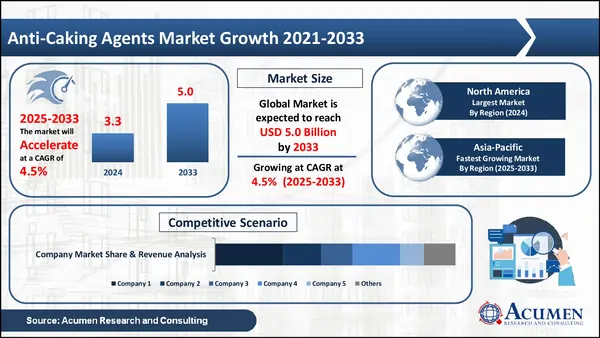The Anti-Caking Agents Market, valued at USD 3.3 Billion in 2024, is anticipated to surpass USD 5.0 Billion by 2033, reflecting a projected CAGR of 4.5%

Anti-caking agents are an essential aspect of the food additives business since they help to maintain product quality and extend shelf life in a range of applications. These functional additives prevent lump formation while maintaining the free-flowing properties of powdered and granulated commodities, solving a major challenge in food processing, pharmaceuticals, and industrial applications. The market has shown strong growth patterns as manufacturers recognize the importance of product consistency and handling efficiency.
The global anti-caking agents market is expanding due to rising demand for convenience foods, increased industrialization of food production, and higher consumer expectations for product quality. Furthermore, scientific developments in ingredient compositions have led in the creation of more effective anti-caking solutions with improved performance properties tailored to specific application needs. These solutions address industry-specific challenges while maintaining compliant with evolving regulatory frameworks and consumer expectations.
The transformation of anti-caking agent formulations toward natural and clean label alternatives represents a fundamental market driver. This paradigm shift is the result of increased consumer awareness about ingredient transparency and a growing preference for minimally processed food items. Manufacturers have responded by creating plant-derived alternatives to classic synthetic agents, using substances like rice hulls, cellulose derivatives, and modified starches to provide equal functionality while meeting clean label regulations.
Regulatory advancements have hastened this transition, with food safety authorities enforcing stricter rules for permitted additive concentrations and usage settings. Simultaneously, advances in processing technology have allowed for more efficient application methods, resulting in lower required volumes while maintaining efficacy. This optimization provides cost savings while also addressing consumer concerns about additive consumption.
Research indicates that naturally-derived anti-caking agents demonstrate superior market growth rates compared to their synthetic counterparts, with annual expansion exceeding 6% in developed markets. This trend correlates directly with broader movements toward ingredient simplification and artificial additive reduction across the processed food landscape. Industry leaders have recognized this shift, allocating significant resources toward natural solution development to maintain competitive positioning.
The pharmaceutical sector offers enormous growth opportunities for anti-caking agent makers through tailored formulations that satisfy the specific needs of medical preparations and dietary supplements. This high-value application environment needs precision-engineered solutions that provide perfect ingredient stability while meeting stringent regulatory standards.
Current pharmaceutical applications rely mostly on silicon dioxide derivatives and stearate compounds, which have limits in terms of compatibility with sensitive active components. Next-generation formulations overcome these constraints by adding pharmaceutical-grade natural alternatives with higher chemical inertness and lower interaction potential. These specialized solutions command a premium price and much bigger margins than standard food-grade alternatives.
The nutraceutical industry represents a particularly promising growth vector, with powdered supplement formulations requiring effective anti-caking solutions to maintain dosage accuracy and product integrity. The complex constituent matrices included in these goods create distinct problems in terms of moisture management and particle interaction, demanding techniques that go beyond normal food grade solutions.
The anti-caking agent market is undergoing a transformational shift toward multifunctional formulations that provide benefits beyond traditional flow-enhancement capabilities. This advanced solution provides a value-added proposition for firms looking to reduce ingredient declarations while also tackling various manufacturing difficulties at once.
Advanced anti-caking technologies now include antibacterial qualities, resulting in longer shelf life and improved flow. These dual-function chemicals meet food safety standards while lowering the overall additive burden in finished products. Similarly, fortified anti-caking compounds including nutritional components like calcium or magnesium provide functionality while also improving product nutritional profiles, which is a key advantage in fortified food applications.
The worldwide anti-caking agents market is divided into 4 segments: source, type, application, and regional markets
The anti-caking agents market exhibits distinctive regional characteristics influenced by local manufacturing practices, regulatory frameworks, and consumer preferences. North America and Europe continue to be market leaders, accounting for over 60% of global consumption value due to advanced food processing sectors and high quality requirements. These established markets indicate mature adoption trends across a wide range of application categories.
The Asia-Pacific area has the most dynamic growth environment, with China, India, and Southeast Asian countries witnessing significant expansion due to modernizing food production facilities and increased processed food consumption. Regional market development is defined by the adoption of cost-effective solutions tailored to local manufacturing conditions and climate constraints, particularly humidity management in tropical areas.
Anti-caking agents companies profiled in the report includes Brentagg A.G., Agropur Ingredients, Cabot Corporation, J.M. Huber Corporation, Evonik Industries, Kao Corporation, Solvay S.A., PPG Industries Inc., and Univar Inc.
|
Parameter |
Details |
|
Size in 2024 |
USD 3.3 Billion |
|
Forecast by 2033 |
USD 5.0 Billion |
|
CAGR Source 2025 - 2033 |
4.5% |
|
Largest Genre Segment (% Share 2024) |
Natural – 55% |
|
Largest Region Size (2024) |
North America - USD 1.2 Billion |
|
Fastest Growing Region (% CAGR) |
Asia-Pacific – 5.1% |
|
Key Players Covered |
Brentagg A.G., Agropur Ingredients, Cabot Corporation, J.M. Huber Corporation, Evonik Industries, Kao Corporation, Solvay S.A., PPG Industries Inc., and Univar Inc. |
|
Request Customization |
Mr. Richard Johnson
Acumen Research and Consulting
India: +91 8983225533